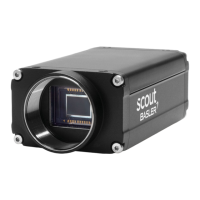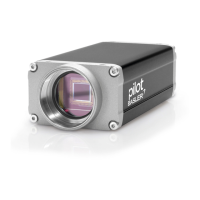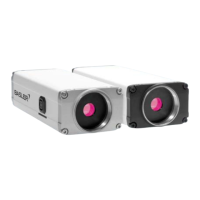Standard Features AW00089317000
266 Basler ace GigE
10.10.2 Considerations When Using Decimation
Reduced Vertical Resolution
Using vertical decimation effectively reduces the vertical resolution of the camera’s imaging sensor.
For example, the sensor in the acA2000-50gm camera normally has a resolution of 2048 (H) x
1088 (V). If you set this camera to use vertical decimation by 5, the effective resolution of the sensor
is reduced to 2048 (H) by 217 (V).
If you reduce the vertical resolution by using the vertical decimation feature, you can increase the
frame rate of the camera.
Possible Image Distortion
Objects will only appear undistorted in the image, if the numbers of lines and columns are equal.
With all other combinations, the imaged objects will appear distorted. If, for example, vertical
decimation is set to 2, the imaged objects will appear shrunk by a factor of 2 compared to an image
without vertical decimation.
Binning and Vertical Decimation
If vertical binning is used, vertical decimation is automatically disabled, and vice versa, i.e. if vertical
decimation is used, vertical binning is disabled.
Horizontal binning works independently from the decimation feature.
Decimation’s Effect on AOI Settings
When you have the camera set to use decimation, keep in mind that the settings for your area of
interest (AOI) will refer to the lines in the sensor and not to the physical lines in the sensor as they
normally would.
For detailed information on the effect of the decimation feature on the AOI settings, see section
"Possible Image Distortion" on page 262.
AOI height
If you use the vertical decimation feature and you reset the decimation parameter
back to 1, i.e. the vertical decimation feature is deactivated, the AOI height can be
smaller than the maximum possible height (determined by the pixel resolution in
vertical direction).
In this case you can manually set the AOI height back to the maximum possible
height.

